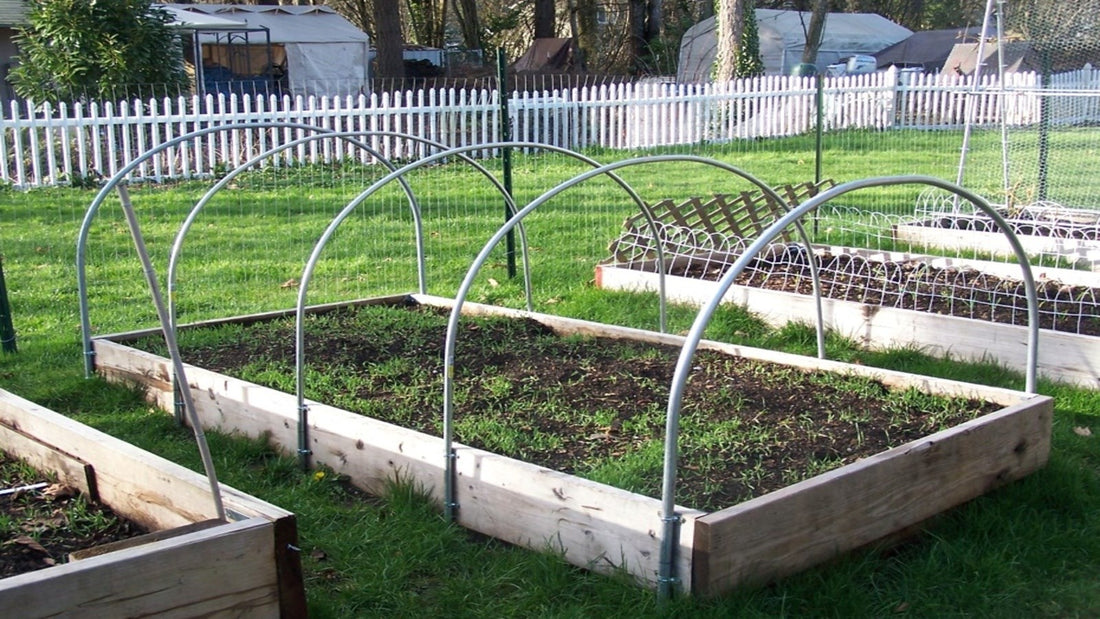Creating hoops for raised beds is an essential gardening technique that enhances plant growth and protection and extends the growing season. This guide will walk you through 4 easy methods for constructing hoops using materials like black poly tubing, PVC, and metal conduit:
1. 1/2 inch Black Poly Tubing Hoops
For gardeners seeking a cost-effective and straightforward method to create hoops for raised beds, the use of 1/2 inch black poly tubing offers an excellent solution. This material is widely favored for its flexibility and ease of handling, making it ideal for gardeners of all experience levels.
- Material Specifics:The tubing used is 1/2 inch in diameter, composed of black polyethylene-a durable, flexible material well-suited for outdoor conditions.
- Required Tools:For cutting the tubing to desired lengths, a utility knife or a specialized tube and pipe cutter can be used. The latter tool is particularly recommended for those seeking a clean cut without the risk of injury.
- Installation Process: To secure the hoops, gardeners have two main options. One can directly push the ends of the tubing into the soil, which is straightforward but may be less stable in softer soils. Alternatively, using tube straps screwed into the wooden sides of the raised bed can provide a more robust setup. These straps ensure that the hoops remain firmly in place, even under windy conditions or when supporting the weight of a cover.
- Optimal Use:The 1/2 inch black poly tubing hoops are best used for supporting lightweight materials such as row covers or bird netting. The inherent flexibility of the tubing, while a benefit for installation and handling, limits its ability to support heavier coverings like thick plastic or hail cloth.
- Cost Efficiency:With a total cost of under $5 for a complete set of hoops within a standard raised bed, this method stands out as highly affordable. This low cost makes it accessible to gardeners on a budget or those managing multiple beds who need an economical solution for plant protection.

2. 1/2 inch Schedule 40 PVC Hoops
The 1/2-inch Schedule 40 PVC hoops provide a robust option for gardeners looking to support heavier cover materials over their raised beds. These hoops are specifically designed to offer enhanced durability and support, suitable for diverse gardening needs.
- Material Specifications:Made from 1/2 inch Schedule 40 PVC, this type of piping is known for its strength and resistance to wear. It is thicker and more rigid than many other types of plastic piping, making it an ideal choice for garden structures.
- Tools Required: The only tool needed to cut this PVC to the desired lengths is a PVC cutter. This specialized tool ensures clean and precise cuts, essential for maintaining the integrity and stability of the hoops.
- Installation Technique:For installation, the PVC hoops are anchored using straps that are fixed to the sides of the raised bed. This method involves bending the PVC into an arc that spans across the bed. The straps, which are securely screwed into the bed's frame, hold the ends of the PVC in place, preventing movement and providing a stable base for the hoops.
- Appropriate Applications:Due to its increased rigidity, Schedule 40 PVC is best suited for supporting heavier coverings like hail cloth, dense shade cloth, and thicker plastic sheets. These materials often require a stronger framework to handle the additional weight and to withstand external elements like wind or heavy rain.
- Height and Coverage:Once installed, these hoops stand approximately 24 inches above the soil. This height makes them particularly beneficial for protecting taller plant varieties that need space to grow upward or require a more extensive coverage area for optimal development.
3. 3/4 inch PVC Hoops with Rebar
For gardeners who need robust support for very tall plants or heavy-duty coverings, 3/4 inch PVC hoops with rebar provide an excellent structure, standing at a substantial height of approximately 50 inches above the soil. This setup is particularly useful for protecting larger plant varieties and in areas exposed to harsh weather conditions.
- Material Overview:The hoops are crafted from 3/4 inch PVC, which is not cut and used in its full 10-foot length. This size of PVC offers a blend of flexibility and strength, making it capable of spanning larger distances over raised beds without sagging or breaking.
- Tools and Installation:Remarkably, this method requires no cutting tools, simplifying the installation process. Instead, rebar stakes are used as the primary support mechanism. These metal stakes are driven into the ground at intervals along the length of the raised bed, and the PVC pipes are then arched and slid over the protruding rebar, creating a secure and stable hoop structure.
- Optimal Uses:This system is best suited for very tall plants, such as climbing vines or high-growing vegetables that require space to thrive. It is also ideal for supporting heavy-duty coverings, including thick plastic sheeting for winter protection or hail netting during stormy seasons. The height and strength of these hoops make them versatile for various gardening needs throughout the year.
- Additional Structural Support:To further enhance stability, especially in windy or snowy conditions, 1 x 2 fir strips are used to reinforce the hoops. These wooden strips are placed along the outside of the hoops and secured at the top, acting as a brace that holds the structure firmly in place. This additional support is crucial in preventing the hoops from collapsing under the weight of snow or bending in strong winds.

4. Metal Conduit Hoops
Metal conduit hoops, constructed from 3/4 inch steel metal conduit, provide a highly durable and weather-resistant option for raised bed gardening. These hoops are designed to offer long-term reliability, especially in environments where robust structures are necessary due to harsh weather conditions.
- Material Details:The 3/4 inch steel metal conduit used for these hoops is significantly tougher than plastic alternatives like PVC. The steel's high strength and resistance to bending or breaking under stress make it ideal for garden settings where durability is crucial.
- Tools Required:To shape these metal conduits into hoops, a conduit bending jig is essential. This tool can be either purchased or built at home. The jig allows for precise bending of the steel conduit to ensure even arcs that are consistent for each hoop, which is crucial for maintaining the integrity and aesthetics of the garden setup.
- Installation Method:Once bent into the desired shape, the ends of the conduit are slid over rebar stakes that have been driven into the ground at the edges of the raised garden bed. This method anchors the hoops securely, providing a stable base that can support various types of garden coverings.
- Appropriate Uses: Metal conduit hoops are particularly well-suited for environments that require structures to withstand elements like strong winds, heavy snow, or intense sun. Their resilience makes them ideal for high hoops that need to span larger areas without sagging or collapsing.
- Cost Efficiency:The total cost for setting up metal conduit hoops is approximately $20 per arrangement. This includes the price of the steel conduit, rebar stakes, and any additional hardware needed for assembly. While slightly more expensive than some plastic alternatives, the investment in metal conduit hoops is justified by their superior longevity and reduced need for replacement.
Why Raised Beds Need Hoops
To fully maximize the advantages of raised beds and extend the gardening season, installing hoops over these beds is often necessary:
- Enhanced Plant Protection: Hoops provide a physical barrier that protects plants from various external threats. By supporting materials like bird netting or row covers, hoops safeguard young seedlings and mature plants from pests, birds, and small animals that might otherwise devour or damage them.
- Climate Control:One of the most significant advantages of using hoops on raised beds is the ability to create microclimates that can drastically improve plant growth and survival. Hoops covered with plastic sheeting can turn a raised bed into a mini greenhouse, retaining heat and humidity during the cooler early and late parts of the growing season. This allows gardeners to start their season earlier and extend it later than would be possible otherwise.
- Weather Shield:Beyond temperature control, hoops also protect plants from harsh weather conditions. Heavy rains, hail, and strong winds can damage plants, but a well-constructed hoop setup with the appropriate cover can minimize this impact, ensuring that plants remain healthy and undamaged through unpredictable weather.
- Disease Prevention: Hoops can also play a crucial role in disease prevention. By controlling moisture levels on the plant surface, covers on hoops can help prevent the development and spread of many common plant diseases, which often thrive in wet conditions. This is particularly important in regions prone to prolonged damp weather.
- Aesthetic and Structural Benefits:Hoops can also enhance the structural organization and aesthetic appeal of a garden. A neatly arranged series of hoops in a garden can provide a tidy and professional appearance, while also making the management of plants easier during all phases of growth. Additionally, the ability to remove or replace covers easily gives gardeners flexibility in how they manage their plant care through the season.
The Bottom Line

Installing hoops over raised beds is a strategic move that not only protects plants but also creates a more controlled growing environment. Whether you choose lightweight poly tubing, versatile PVC, or durable metal conduit, each option offers unique benefits tailored to specific gardening needs. By implementing these hoop structures, gardeners can enhance the productivity and longevity of their garden beds, making the most out of every planting season. Invest in the right hoop setup to ensure your garden thrives, regardless of external conditions.
Read More
- Raised Garden Beds Tips | Learn Optimal Size & Height
- Right Metal Raised Garden Bed Size | Optimal Plant Growth Guide
- Growing Trees in Metal Raised Beds | Tips & Considerations Revealed
- Raised Bed Filling Guide | Anleolife Gardening Tips
- Effortless Raised Bed Filling | Eco-Conscious Gardening | Anleolife

